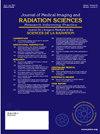肺部立体定向消融放射治疗的个性化运动管理
IF 1.3
Q3 RADIOLOGY, NUCLEAR MEDICINE & MEDICAL IMAGING
Journal of Medical Imaging and Radiation Sciences
Pub Date : 2024-10-01
DOI:10.1016/j.jmir.2024.101525
引用次数: 0
摘要
背景/目的SABR 是一期肺癌的主要治疗方案。我们提供肺部 SABR 治疗已有 10 年之久。这些患者通常在自由呼吸状态下接受治疗,在治疗计划中通过内部靶体积概念将呼吸运动考虑在内。但对于下叶的目标,明显的呼吸运动可能导致目标体积增大,增加对周围健康组织的剂量。另一种运动管理方法是深吸气屏气(DIBH)。2023 年,该服务启动了一项关于 DIBH 肺 SABR 的试点研究,并开展了一项回顾性审计,以评估重复屏气时目标位置的可靠性。该审计通过分析在重复屏气治疗过程中拍摄的分内成像 (IFI) CBCT,评估了前八名患者屏气间目标重新定位的残余变化。根据这些数据,对变异最大的患者进行了进一步分析。应用各自 IFI CBCT 的残余定位误差,在治疗计划系统中重新创建了四个分区,并创建了这四个分区的总计划,将剂量统计与原始计划进行比较。结果这名患者的总体最大误差为纵向 0.76 厘米、横向 0.31 厘米和纵向 0.26 厘米,所有误差仍在计划目标体积内。多学科团队对患者的设置进行了讨论。通过将每日残余误差应用于 "每分计划",然后汇总为最终的 "治疗计划",对计划进行了审查--所有剂量统计数据均与原始计划相当。根据 "每日治疗 "的目标位置重新计算这名患者的计划,再次证明了 DIBH 技术中的肺部 SABR 是自由呼吸 SABR 的一种有价值的替代方法。本文章由计算机程序翻译,如有差异,请以英文原文为准。
Personalised motion management for Stereotactic Ablative Radiation Therapy to the Lung
Background/Purpose
SABR is a mainstay treatment option for stage 1 lung cancer. Our service has offered lung SABR treatment for 10 years. Standardly, these patients are treated in free breathing, with breathing motion accounted for in treatment planning, via Internal Target Volume concept. For targets in lower lobes though, significant breathing motion could lead to larger target volumes and increased dose to surrounding healthy tissue. An alternative motion management approach is deep inspiration breath-hold (DIBH). In 2023, the service initiated a pilot study on Lung SABR in DIBH and undertook a retrospective audit assessing the reliability of target position in repeated breath-hold.
Method
The audit assessed the residual inter-breath-hold target repositioning variability for the first eight patients by analysing intra-fractional imaging (IFI) CBCT taken during treatment delivery in repeated breath-hold. From this data, the patient with the most variability was analysed further. Each of the four fractions were re-created in the treatment planning system, applying the residual positioning error from the respective IFI CBCT and a sum plan of these four plans was created to compare dose statistics to the original plan.
Results
This patient's overall largest errors were 0.76cm in longitudinal, 0.31cm lateral and 0.26cm vertical directions, all still within the planning target volume. The patient's setup was discussed within a multidisciplinary team. A plan review was performed by applying the daily residual errors to a "plan per fraction" and then summed to a final "treated plan" - all dose statistics were comparable to the original plan.
Conclusion
Lessons were learned from this complex patient and hence implemented. The re-calculation of this patient's plan with target position "as treated daily" provided reassurance that the Lung SABR in DIBH technique is a valuable alternative to SABR in free breathing.
求助全文
通过发布文献求助,成功后即可免费获取论文全文。
去求助
来源期刊

Journal of Medical Imaging and Radiation Sciences
RADIOLOGY, NUCLEAR MEDICINE & MEDICAL IMAGING-
CiteScore
2.30
自引率
11.10%
发文量
231
审稿时长
53 days
期刊介绍:
Journal of Medical Imaging and Radiation Sciences is the official peer-reviewed journal of the Canadian Association of Medical Radiation Technologists. This journal is published four times a year and is circulated to approximately 11,000 medical radiation technologists, libraries and radiology departments throughout Canada, the United States and overseas. The Journal publishes articles on recent research, new technology and techniques, professional practices, technologists viewpoints as well as relevant book reviews.
 求助内容:
求助内容: 应助结果提醒方式:
应助结果提醒方式:


